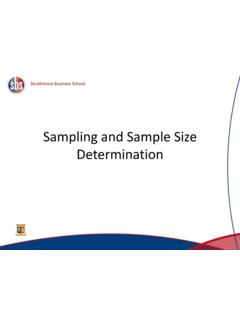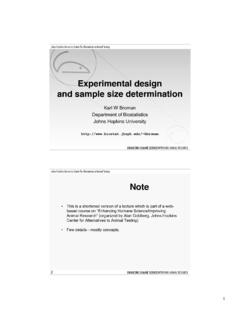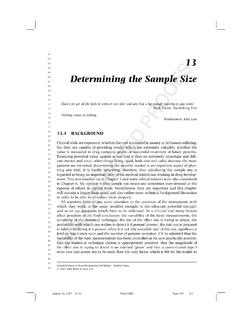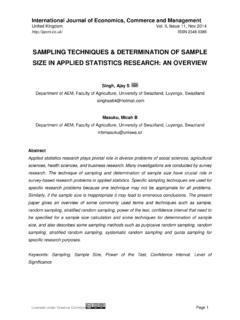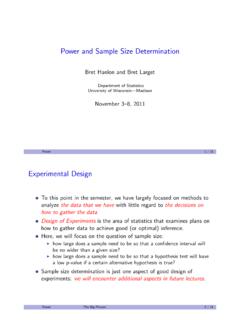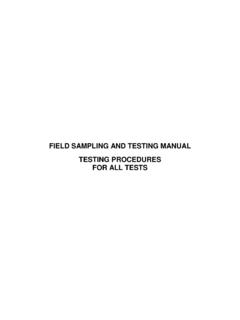Transcription of Some Practical Guidelines for Effective Sample-Size ...
1 Some Practical Guidelines for Effective Sample-Size DeterminationRussell V. Lenth Department of StatisticsUniversity of IowaMarch 1, 2001 AbstractSample- size determination is often an important step in planning a statistical study and it is usuallya difficult one. Among the important hurdles to be surpassed, one must obtain an estimate of one ormore error variances, and specify an effect size of importance. There is the temptation to take someshortcuts. This paper offers some suggestions for successful and meaningful Sample-Size discussed is the possibility that sample size may not be the main issue, that the real goal is todesign a high-quality study. Finally, criticism is made of some ill-advised shortcuts relating to powerand sample words:Power; sample size ; Observed power; Retrospective power; Study design; Cohen s effectmeasures; Equivalence testing; I wish to thank John Castelloe, Kate Cowles, Steve Simon, two referees, an editor, and an associate editor for their helpfulcomments on earlier drafts of this paper.
2 Much of this work was done with the support of the Obermann Center for AdvancedStudies at the University of sample size and powerStatistical studies (surveys, experiments, observational studies, etc.) are always better when they are care-fully planned. Good planning has many aspects. The problem should be carefully defined and operational-ized. Experimental or observational units must be selected from the appropriate population. The study mustbe randomized correctly. The procedures must be followed carefully. Reliable instruments should be usedto obtain , the study must be of adequate size , relative to the goals of the study. It must be big enough that an effect of such magnitude as to be of scientific significance will also be statistically significant. It isjust as important, however, that the study not be too big, where an effect of little scientific importance isnevertheless statistically detectable.
3 sample size is important for economic reasons: An under-sized studycan be a waste of resources for not having the capability to produce useful results, while an over-sized oneuses more resources than are necessary. In an experiment involving human or animal subjects, sample sizeis a pivotal issue for ethical reasons. An under-sized experiment exposes the subjects to potentially harmfultreatments without advancing knowledge. In an over-sized experiment, an unnecessary number of subjectsare exposed to a potentially harmful treatment, or are denied a potentially beneficial such an important issue, there is a surprisingly small amount of published literature. Important gen-eral references include Mace (1964), Kraemer and Thiemann (1987), Cohen (1988), Desu and Raghavarao(1990), Lipsey (1990), Shuster (1990), and Odeh and Fox (1991).
4 There are numerous articles, especiallyin biostatistics journals, concerning Sample-Size determination for specific tests. Also of interest are studiesof the extent to which sample size is adequate or inadequate in published studies; see Freiman et al. (1986)and Thornley and Adams (1998). There is a growing amount of software for Sample-Size determination ,includingnQuery Advisor(Elashoff, 2000),PASS(Hintze, 2000),UnifyPow(O Brien, 1998), andPowerand Precision(Borenstein et al., 1997). Web resources include a comprehensive list of power-analysis soft-ware (Thomas, 1998) and online calculators such as Lenth (2000). Wheeler (1974) provides some usefulapproximations for use in linear models; Castelloe (2000) gives an up-to-date overview of are several approaches to sample size . For example, one can specify the desired width of aconfidence interval and determine the sample size that achieves that goal; or a Bayesian approach can beused where we optimize some utility function perhaps one that involves both precision of estimation andcost.
5 One of the most popular approaches to Sample-Size determination involves studying the power of a testof hypothesis. It is the approach emphasized here, although much of the discussion is applicable in othercontexts. The power approach involves these elements:1. Specify a hypothesis test on a parameter (along with the underlying probability model for the data).2. Specify the significance level of the Specify aneffect size that reflects an alternative of scientific Obtain historical values or estimates of other parameters needed to compute the power function of Specify a target value of the power of the test when = .Notationally, the power of the test is a function ( ,n, ,..)wherenis the sample size and the .. partrefers to the additional parameters mentioned in step 4.
6 The required sample size is the smallest integernsuch that ( ,n, ,..) .2 Figure 1: Software solution (Java applet in Lenth, 2000) to the Sample-Size problem in the illustrate, suppose that we plan to conduct a simple two-sample experiment comparing atreatment with a control. The response variable is systolic blood pressure (SBP), measured using a standardsphygmomanometer. The treatment is supposed to reduce blood pressure; so we set up a one-sided test ofH0: T= CversusH1: T< C, where Tis the mean SBP for the treatment group and Cis the meanSBP for the control group. Here, the parameter = T Cis the effect being tested; thus, in the aboveframework we would writeH0: =0 andH1: < goals of the experiment specify that we want to be able to detect a situation where the treatmentmean is 15 mm Hg lower than the control group; , the required effect size is = 15.
7 We specify thatsuch an effect be detected with 80% power ( =.80) when the significance level is =.05. Past experiencewith similar experiments with similar sphygmomanometers and similar subjects suggests that the datawill be approximately normally distributed with a standard deviation of =20 mm Hg. We plan to use atwo-sample pooledttest with equal numbersnof subjects in each we have all of the specifications needed for determining sample size using the power approach, andtheir values may be entered in suitable formulas, charts, or power-analysis software. Using the computerdialog shown in Figure 1, we find that a sample size ofn=23 per group is needed to achieve the statedgoals. The actual power is . example shows how the pieces fit together, and that with the help of appropriate software, Sample-Size determination is not technically difficult.
8 Defining the formal hypotheses and significance level arefamiliar topics taught in most introductory statistics courses. Deciding on the target power is less idea is that we want to have a reasonable chance of detecting the stated effect size . A target value of .80is fairly common and also somewhat minimal some authors argue for higher powers such as .85 or .90. Aspower increases, however, the required sample size increases at an increasing rate. In this example, a targetpower of =.95 necessitates a sample size ofn=40 almost 75% more than is needed for a power of . main focus of this article is the remaining specifications (items (3) and (4)). They can presentsome real difficulties in practice. Who told us that the goal was to detect a mean difference of 15 mm Hg?3 How do we know that =20, given that we are only planning the experiment and so no data have beencollected yet?
9 Such inputs to the Sample-Size problem are often hard-won, and the purpose of this articleis to describe some of the common pitfalls. These pitfalls are fairly well known to practicing statisticians,and are discussed in several applications-oriented papers such as Muller and Benignus (1992) and Thomas(1997); but there is not much discussion of such issues in the mainstream statistical an effect size of scientific importance requires obtaining meaningful input from the researcher(s)responsible for the study. Conversely, there are technical issues to be addressed that require the expertise ofa statistician. Section 2 talks about each of their contributions. Sometimes, there are historical data that canbe used to estimate variances and other parameters in the power function. If not, a pilot study is needed.
10 Ineither case, one must be careful that the data are appropriate. These aspects are discussed in Section many Practical situations, the sample size is mostly or entirely based on non-statistical criteria. Sec-tion 4 offers some suggestions on how to examine such studies and help ensure that they are 5 makes the point that not all Sample-Size problems are the same, nor are they all equally also discusses the interplay between study design and sample it can be so difficult to address issues such as desired effect size and error variances, people tryto bypass them in various ways. One may try to redefine the problem, or rely on arbitrary standards; seeSection 6. We also argue against various misguided uses of retrospective power in Section subsequent exposition makes frequent use of terms such as science and research.

